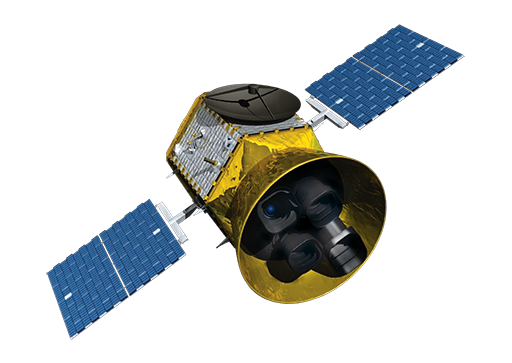The Transiting Exoplanet Survey Satellite – TESS
TESS is a NASA mission that launched in March 2018. It is a small space telescope dedicated to searching for transiting planets around nearby, bright stars.
Activity _unit9.5.2 Activity 4 Planets orbiting nearby stars
Why are planets orbiting bright, nearby stars particularly important?
Answer
You learned in Week 7 that it’s much easier to make good measurements when the star emits plenty of light, and the nearer the star is the brighter it will appear. Collecting a lot of light allows astronomers to make more detailed measurements and means the measurement uncertainties are relatively small.
Finding planets around bright, nearby stars will allow follow-up observations from large ground-based telescopes that weren’t possible for many of the Kepler planets. Kepler has helped astronomers make huge strides in working out the numbers of planets that are out there, but TESS will discover planets that can be studied in remarkable detail.

TESS aims to study 200 000 of the brightest, closest stars, covering an area of the sky 400 times larger than that covered by the Kepler mission, as shown in Figure 14. The expectation is that TESS will find thousands of transiting exoplanet candidates. But what kind of planets will these be?
TESS is capable of finding planets as small as Earth, especially around smaller stars, but it’s unlikely to find Earth twins. This is because it has to keep changing which bit of sky it’s looking at to make sure it covers the whole of the sky. It will therefore not spend very long looking at any particular patch, so it will only be able to detect planets with relatively short periods. A true Earth twin orbiting a Sun-like star would have a period of approximately a year, which would take several years of observation to detect – we need at least three transits to be confident we have discovered an orbiting planet.
Activity _unit9.5.3 Activity 5 TESS planets
TESS is likely to find lots of planets with relatively short orbital periods, close to their parent stars. How do you think these planets are likely to compare with the planets in the Solar System?
Answer
Most TESS planets are likely to be orbiting close to their stars, so they will be very hot – much hotter than the planets in the Solar System.
TESS has already had three planets confirmed from its first three months of observations, with hundreds more candidates being followed up using ground-based observatories. One of these, LHS 3844 b, is only a little larger than Earth, but has an orbital period of just 11 hours – a ‘hot Earth’! A big question is whether such a planet so close to its star could retain any kind of atmosphere. Being just 50 light years away it will be an ideal subject for transmission spectroscopy to find out.

